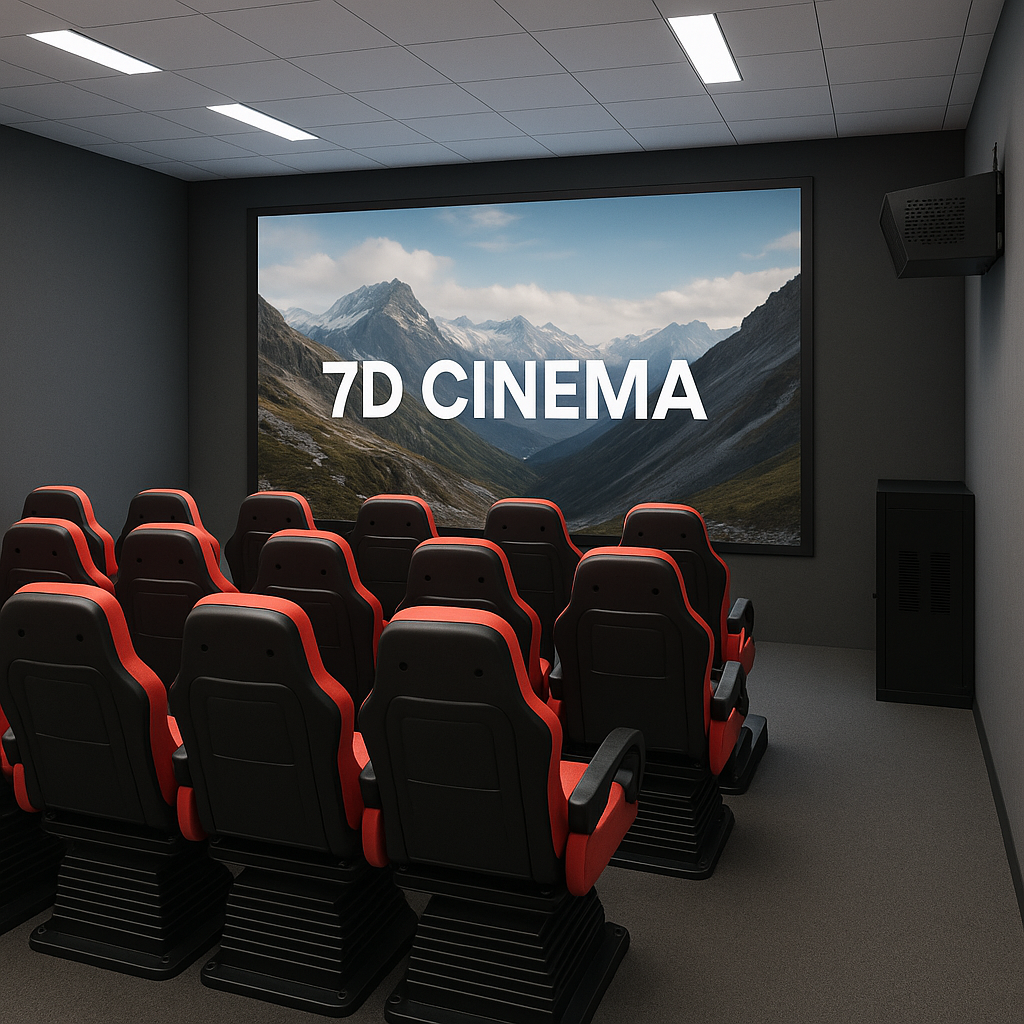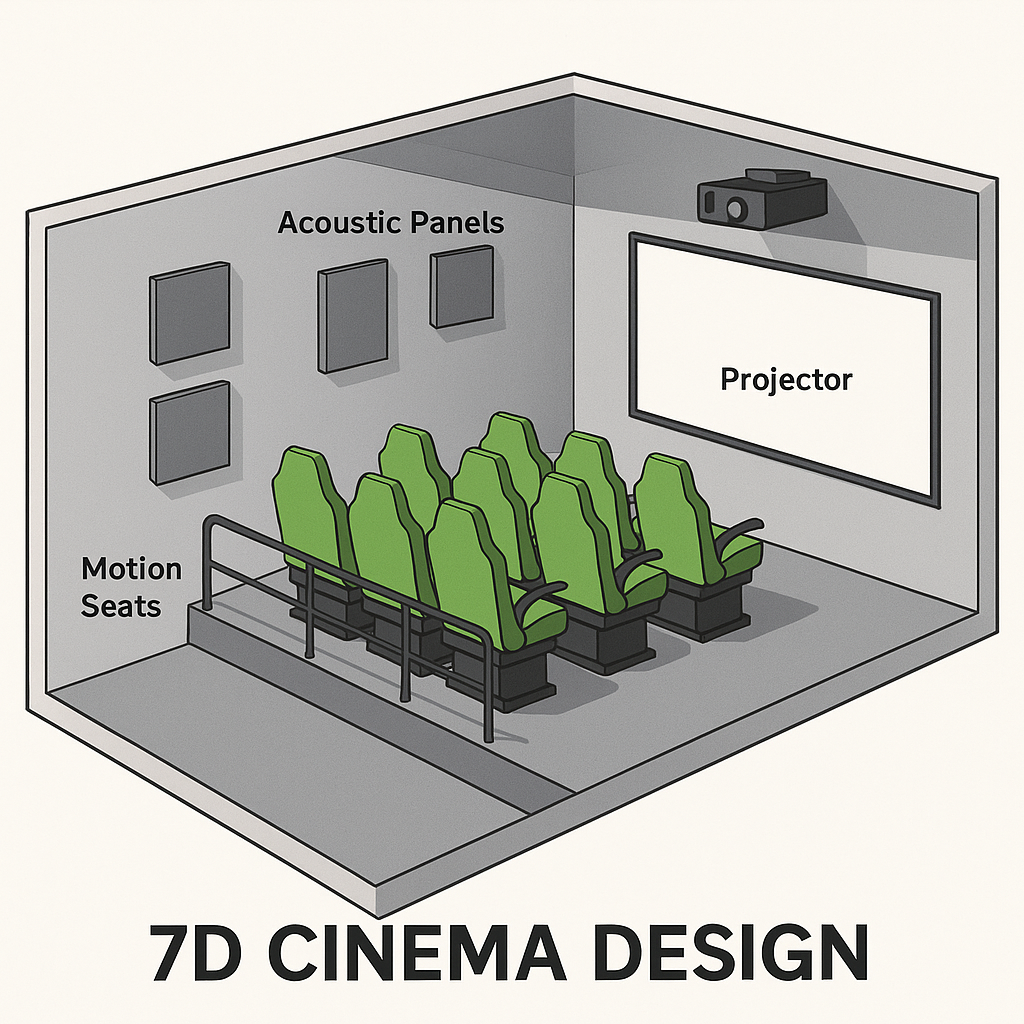Introduction: Smart Preparation Leads to Smooth Operation
Setting up a 7D cinema is not just about buying the right machines — it’s about preparing the right environment to make everything work perfectly.
Before installation begins, investors need to plan carefully for space allocation, power load, ventilation, and safety systems.
At VART, we have seen that well-prepared locations reduce 70% of installation delays and improve long-term reliability.
This guide explains the key aspects of designing your space, selecting the right setup, and ensuring every system runs safely and efficiently.
Step 1 — Understand the Installation Framework
A complete 7D cinema system combines four main technical areas:
-
Motion seat platforms (6DOF/3DOF) – provide realistic physical feedback.
-
Projection and sound systems – deliver immersive visuals and spatial audio.
-
Environmental effects machines – add rain, wind, smoke, bubbles, or scent.
-
Control and synchronization systems – ensure everything moves in sync with the movie.
Each of these systems must be considered during construction — especially in wiring routes, floor reinforcement, and cooling design.
Step 2 — Space Planning by Capacity
7D cinemas can fit a wide range of venue types. Whether it’s a compact 30-seat room or a full-scale 100-seat attraction, planning for space, comfort, and accessibility is crucial.
30-Seat Setup
Ideal for shopping malls or medium indoor venues.
-
Required area: about 60–80㎡
-
Suitable for 3–5 rows of motion chairs with a small backstage for maintenance.
-
Projection and control areas can be placed behind the audience or on an upper deck.
60-Seat Setup
Perfect for indoor amusement centers or VR theme parks.
-
Required area: 120–150㎡
-
Two synchronized motion platforms are often used.
-
Independent AC zones are recommended to prevent temperature rise from equipment.
100-Seat Setup
Designed for large-scale operations and tourist centers.
-
Required area: 200–250㎡
-
Stadium seating improves sight lines.
-
Requires a larger power supply, stronger sound isolation, and wider exits for crowd safety.
Step 3 — Electrical and Network Requirements
Electrical design determines performance and safety.
A stable power system avoids seat jerks, audio lag, and synchronization loss.
Power Setup Guidelines
-
Voltage: 220V–380V (based on national standard)
-
Power load: 20–60 kW depending on seat capacity
-
Protection: Each system (motion seats, projection, effects) needs its own breaker
-
Backup: Include UPS and stabilizer to protect control systems
Network Setup
Modern 7D theaters often include interactive shooting or cloud-based scoring systems.
-
A dedicated LAN ensures stable signal between devices.
-
Secure internet access allows remote monitoring and software updates.
Step 4 — Environmental Design: Sound, Air & Safety
A 7D cinema must control sound, heat, and audience safety to deliver the best experience.
Soundproofing
-
Use multi-layer wall panels or acoustic foam to block vibration noise.
-
Keep a minimum gap between the platform and structural walls.
-
Add insulation under the platform for low-frequency damping.
Ventilation & Cooling
-
Air ducts or ceiling diffusers are vital to remove heat from motion seats and effect generators.
-
Separate AC systems for projection and control rooms are recommended.
-
Keep humidity below 60% to protect electronic components.
Safety Requirements
-
Fire alarms and emergency lights must comply with local codes.
-
Floor reinforcement should meet dynamic load standards.
-
Cable trays should be elevated to prevent tripping or overheating.
Step 5 — Equipment Layout Planning
A well-planned layout not only improves visual immersion but also makes maintenance easier.
| Zone | Equipment | Function |
|---|---|---|
| Front | Screen, speakers | Main display area |
| Center | Motion seats | Audience immersion |
| Side & Back | Effects (fog, wind, water) | Environmental simulation |
| Rear | Control & server systems | Synchronization & monitoring |
A clear functional division prevents overheating and makes the system easier to service.
Cable lines should be labeled, grouped, and hidden beneath floor channels for safety and aesthetics.
Step 6 — Installation and Calibration
During on-site installation, every system is tested and synchronized.
-
Motion seat platforms are leveled and tested for balance.
-
Effect devices are positioned to match scene directions (e.g., wind left/right).
-
The control system is programmed to synchronize with movie timing.
At VART, our engineers handle calibration, sound balancing, and training — ensuring your cinema is ready for commercial launch immediately after testing.
Step 7 — Maintenance Planning for Longevity
A 7D cinema is a long-term investment. Preventive maintenance is key to smooth operation and consistent revenue.
Tips for better maintenance:
-
Clean filters and seat actuators regularly.
-
Run daily self-tests before opening to detect faults early.
-
Schedule software updates monthly for stable synchronization.
-
Keep spare parts like sensors and air pipes ready for quick repair.
With VART’s remote support and diagnostic tools, operators can easily track system health and resolve minor issues before they escalate.
Conclusion — Plan It Right, Run It Smooth
The success of a 7D cinema project depends on planning, layout, and professional installation.
A site that’s built with correct electrical systems, space ratios, and airflow not only performs better but also lasts longer.
VART provides complete turnkey 7D cinema installation services, including:
-
Architectural layout design
-
Power and cable schematics
-
Equipment installation and training
-
Global after-sales technical support
Want to know the best configuration for your location?
Contact VART today for a customized 7D cinema layout and investment consultation.
Related Reading
- What Are the Differences Between 5D and 7D Cinemas?
- How Does 7D Cinema Work? Motion Seats & Special Effects
- 7D Cinema Price, Cost and ROI Calculation
Post time: Oct-22-2025


